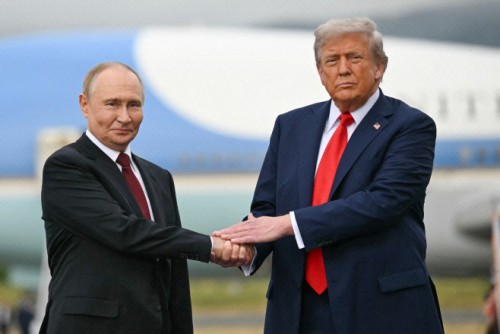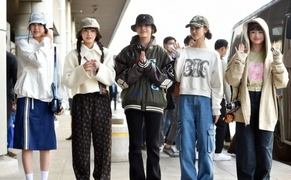 |
| Donald Trump, U.S. president (right), shakes hands with Russian President Vladimir Putin at Joint Base Elmendorf-Richardson in Anchorage, Alaska, on August 15. / Source: AFP-Yonhap News |
A high-stakes White House meeting on August 18 between President Donald Trump, Ukrainian President Volodymyr Zelensky, and major European leaders is expected to serve as a potential turning point toward ending the war in Ukraine.
The talks are reportedly centered on a possible arrangement in which Ukraine cedes parts of the Russian-occupied Donbas region in exchange for NATO-style security guarantees from the U.S. and Europe.
Initially planned as a one-on-one meeting between Trump and Zelensky, the summit has been expanded to include German Chancellor Friedrich Merz, French President Emmanuel Macron, British Prime Minister Keir Starmer, Italian Prime Minister Giorgia Meloni, Finnish Prime Minister Petteri Orpo, European Commission President Ursula von der Leyen, European Council President António Costa, and NATO Secretary-General Mark Rutte.
According to U.S. special envoy Steve Witkoff, who was present at the Trump-Putin meeting in Alaska on August 15, Putin agreed for the first time to allow Western allies to provide Ukraine with NATO-like collective defense guarantees, similar to Article 5 of the NATO treaty. In return, Russia is demanding Ukraine’s withdrawal from parts of Donetsk still held by Kyiv, in exchange for freezing the frontlines in Zaporizhzhia and Kherson and halting further offensives.
Witkoff told Fox News that Russia agreed to legally binding language pledging not to seize more Ukrainian territory or violate European borders after a peace deal. Secretary of State Marco Rubio added that U.S. commitments may be included in any guarantees, calling it “a major shift” in Washington’s position.
The Financial Times reported that European officials view the White House meeting as a critical venue for finalizing these discussions. Zelensky, however, reiterated on social media that security guarantees must provide “practical defense on land, in the air, and at sea” with full European involvement.
The Wall Street Journal noted that the West’s best outcome may be a “Korean-style” settlement, freezing the frontlines and stationing allied troops in Ukraine, much like the U.S. troop presence in South Korea after the 1953 armistice. While Putin could retain control of about 20% of Ukraine’s devastated territory, Western forces would ensure Kyiv’s long-term security, representing what analysts call “a historic failure” for Putin.
European officials privately admit Ukraine is unlikely to fully reclaim all occupied land but stress that Russian control must remain as limited as possible and never receive legal recognition. Zelensky reaffirmed that Ukraine’s constitution prohibits ceding territory but signaled readiness for immediate ceasefire talks leading to a final settlement.
European leaders coordinated positions with Zelensky in Brussels on August 17, stressing the need for U.S. guarantees, an end to hostilities, and joint participation in negotiations.
Trump wrote on his social media platform Truth Social, “BIG PROGRESS ON RUSSIA. STAY TUNED.”
Most Read
-
1
-
2
-
3
-
4
-
5
-
6
-
7





















